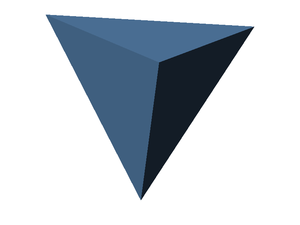Hard tetrahedron model: Difference between revisions
Jump to navigation
Jump to search
Carl McBride (talk | contribs) m (Started a section on Truncated tetrahedra) |
Carl McBride (talk | contribs) mNo edit summary |
||
| Line 4: | Line 4: | ||
It has recently been shown that regular tetrahedra are able to achieve packing fractions as high as <math>\phi=0.8503</math><ref>[http://dx.doi.org/10.1038/nature08641 Amir Haji-Akbari, Michael Engel, Aaron S. Keys, Xiaoyu Zheng, Rolfe G. Petschek, Peter Palffy-Muhoray and Sharon C. Glotzer "Disordered, quasicrystalline and crystalline phases of densely packed tetrahedra", Nature '''462''' pp. 773-777 (2009)]</ref> (the [[hard sphere model |hard sphere]] packing fraction is <math>\pi/(3 \sqrt{2}) \approx 74.048%</math> <ref>[http://dx.doi.org/10.1038/26609 Neil J. A. Sloane "Kepler's conjecture confirmed", Nature '''395''' pp. 435-436 (1998)]</ref>). This is in stark contrast to work as recent as in 2006, where it was suggested that the "...regular tetrahedron might even be the convex body having the smallest possible packing density"<ref>[http://dx.doi.org/10.1073/pnas.0601389103 J. H. Conway and S. Torquato "Packing, tiling, and covering with tetrahedra", Proceedings of the National Academy of Sciences of the United States of America '''103''' 10612-10617 (2006)]</ref>. | It has recently been shown that regular tetrahedra are able to achieve packing fractions as high as <math>\phi=0.8503</math><ref>[http://dx.doi.org/10.1038/nature08641 Amir Haji-Akbari, Michael Engel, Aaron S. Keys, Xiaoyu Zheng, Rolfe G. Petschek, Peter Palffy-Muhoray and Sharon C. Glotzer "Disordered, quasicrystalline and crystalline phases of densely packed tetrahedra", Nature '''462''' pp. 773-777 (2009)]</ref> (the [[hard sphere model |hard sphere]] packing fraction is <math>\pi/(3 \sqrt{2}) \approx 74.048%</math> <ref>[http://dx.doi.org/10.1038/26609 Neil J. A. Sloane "Kepler's conjecture confirmed", Nature '''395''' pp. 435-436 (1998)]</ref>). This is in stark contrast to work as recent as in 2006, where it was suggested that the "...regular tetrahedron might even be the convex body having the smallest possible packing density"<ref>[http://dx.doi.org/10.1073/pnas.0601389103 J. H. Conway and S. Torquato "Packing, tiling, and covering with tetrahedra", Proceedings of the National Academy of Sciences of the United States of America '''103''' 10612-10617 (2006)]</ref>. | ||
==Truncated tetrahedra== | ==Truncated tetrahedra== | ||
<ref>[http://dx.doi.org/10.1103/PhysRevLett.107.155501 Joost de Graaf, René van Roij, and Marjolein Dijkstra "Dense Regular Packings of Irregular Nonconvex Particles", Physical Review Letters '''107''' 155501 (2011)]</ref> | Dimers composed of truncated tetrahedra <ref>[http://dx.doi.org/10.1103/PhysRevLett.107.155501 Joost de Graaf, René van Roij, and Marjolein Dijkstra "Dense Regular Packings of Irregular Nonconvex Particles", Physical Review Letters '''107''' 155501 (2011)]</ref> are able to achieve packing fractions as high as <math>\phi= 207/208 \approx 0.9951923</math> | ||
<ref>[http://dx.doi.org/10.1063/1.3653938 Yang Jiao and Salvatore Torquato "A packing of truncated tetrahedra that nearly fills all of space and its melting properties", Journal of Chemical Physics '''135''' 151101 (2011)]</ref> | <ref>[http://dx.doi.org/10.1063/1.3653938 Yang Jiao and Salvatore Torquato "A packing of truncated tetrahedra that nearly fills all of space and its melting properties", Journal of Chemical Physics '''135''' 151101 (2011)]</ref> | ||
==References== | ==References== | ||
Revision as of 15:52, 17 October 2011

The hard tetrahedron model. Such a structure has been put forward as a potential model for water[1].
Maximum packing fraction
It has recently been shown that regular tetrahedra are able to achieve packing fractions as high as [2] (the hard sphere packing fraction is [3]). This is in stark contrast to work as recent as in 2006, where it was suggested that the "...regular tetrahedron might even be the convex body having the smallest possible packing density"[4].
Truncated tetrahedra
Dimers composed of truncated tetrahedra [5] are able to achieve packing fractions as high as [6]
References
- ↑ Jiri Kolafa and Ivo Nezbeda "The hard tetrahedron fluid: a model for the structure of water?", Molecular Physics 84 pp. 421-434 (1995)
- ↑ Amir Haji-Akbari, Michael Engel, Aaron S. Keys, Xiaoyu Zheng, Rolfe G. Petschek, Peter Palffy-Muhoray and Sharon C. Glotzer "Disordered, quasicrystalline and crystalline phases of densely packed tetrahedra", Nature 462 pp. 773-777 (2009)
- ↑ Neil J. A. Sloane "Kepler's conjecture confirmed", Nature 395 pp. 435-436 (1998)
- ↑ J. H. Conway and S. Torquato "Packing, tiling, and covering with tetrahedra", Proceedings of the National Academy of Sciences of the United States of America 103 10612-10617 (2006)
- ↑ Joost de Graaf, René van Roij, and Marjolein Dijkstra "Dense Regular Packings of Irregular Nonconvex Particles", Physical Review Letters 107 155501 (2011)
- ↑ Yang Jiao and Salvatore Torquato "A packing of truncated tetrahedra that nearly fills all of space and its melting properties", Journal of Chemical Physics 135 151101 (2011)
Related reading


